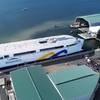Resilient Dutch Network
Key points of the investment-underwritten drive to increase market reach and develop business volume are a push towards larger vessels, up to 20,000-dwt in some cases, and the forging of new relationships with builders in Eastern Europe. Industrial evolution in the north Netherlands has involved an active policy of reinvestment and improvement in the means of shipbuilding production. The rise of new ship and section assembly halls over the windswept landscapes fringed by the Waddenzee and the IJsselmeer is complemented by continuous design development, not least in the industry's core business of supplying dry cargo ships, multi-purpose vessels and container feeder carriers. The design effort couples 'added-value' with series production potential, and marries the vital requirement for construction-friendly forms with a deep understanding of the needs of the ship operator and industrial freight market.
More than ever, the region's strength in shipbuilding and the allied sectors derives not only from its professional skills but also from a propensity for collaboration between like-minded, but wholly-independent firms.
Networking between assembly yards, section builders, cut steel suppliers, marine equipment makers and design engineering firms has conferred a high level of self-sufficiency, while specialization in each case has fostered very high productivity levels. While subcontracting of bare hulls to cheaper-cost countries has long been a policy of certain small-ship and craft builders in the Netherlands, the principle of networking is being extended to include stronger relationships with selected yards in Eastern Europe. Just as the new investments in shipbuilding in the northern and middle regions of the Netherlands have largely complemented rather than displaced existing facilities on the inland waterway network, augmented relationships with yards in Eastern Europe do not signify a diminution in the indigenous shipbuilding resources.
As the latest example of business verve, the recently expanded Volharding Group has signed a new agreement with Daewoo Mangalia Shipyard in Romania paving the way to a growing, annual supply of hulls for outfitting in the Netherlands. The pact with the Korean majority-owned Romanian yard, plus investments in Volharding's two shipyards, specialist outfitting facility and section building yard in Groningen province, should see the group's newbuilding output in 2000 rise to 18 vessels from nine last year. The typically Dutch and German client profile has been broadened by contracts from Mediterranean and Southeast Asian owners for multi-purpose vessels, while the group's market focus now extends from 1,800-dwt to 20,000-dwt, compared to the maximum 9,000-dwt hitherto. One of the key constituents of the industry in the north is the sales, marketing and design engineering firm Conoship International. Jointly owned by the member yards, which include the Volharding Group, Conoship acts as an antenna for the individual builders in the international market, taking a proactive line in business development and the providing project support through to the contract stage, fulfilling a matchmaker role between customers and the shipyards.
Conoship is emblematic of the northern industrial structure and business ethos as a whole, since it lives by generating added-value to the shipbuilders' own commercial and technical endeavors, and in turn gives succor to, and draws benefit from the integrated network. Its impressive, newly-published portfolio of multi-purpose cargo vessels and feederships includes a 15,500-dwt general cargo carrier formulated in conjunction with the Volharding Group. The 730,000-cu ft. class signals an impending new phase in production from a region, which has recently turned out a range of vessels and designs establishing the popularity of the 9,000-dwt size in the multi-purpose scenario. Another example of a Dutch yard having coupled investment in the home ground with a link-up in Eastern Europe is Peters Scheepwerf. The commissioning in 1998 of a new hall for the construction of vessels up to 12,000-dwt has raised the scope of its Kampen premises on the IJssel beyond the traditional coaster sizes. At the same time, a strengthened connection with the Czech shipyard CSPL, for the supply of coaster hulls, has sharpened Peters' competitiveness at the lower end of the capacity band.
Ever-growing Damen Shipyards meanwhile, while maintaining a northern presence with its Hoogezand yard aside the Winschoter Diep near Groningen, last year acquired a majority holding in Santierul Naval Galati in Romania, following five years' cooperation between the Hoogezand and Galtaz yards. New Runners From U.K. And Japanese Stables
With the continuing consolidation in the marine engine building sector, and unwavering pressure on engine prices, the stakes are rising all the time as regards design development. But the considerable resource allocation represented in designing a new engine and bringing it to market have, of course, to be countenanced to ensure competitiveness and respond to new and evolving business opportunities and clients' expectations. At a time when it is set to be taken over by Germany's MAN Group, UK producer Alstom Diesels has unveiled a long-mooted addition to its medium-speed range in the shape of the RK280 series. Conceived initially for unit powers up to about 12,000-bhp (9,000-kW), the 280 mm-bore design promises to be a worthy consort to the popular RK270, which has found particular application in its biggest configurations as a propulsion prime mover in large, high-speed ferries. Tailored to the essential requirement for compact, concentrated power in heavier-payload fast ferries and also military vessels, the RK280 also represents a new initiative in the potential territory of the gas turbine.
Following on from last year's move by Wärtsilä NSD to strengthen its mid-range two-stroke offering with the Sulzer RTA60C, Japanese low-speed diesel engine designer Mitsubishi has announced an addition to its UE family. With the UEC68LSE, the Japanese firm has put a finer edge on competition in a segment of the business with an established contender at 680 mm-bore, the Sulzer RTA68T, and with the MAN B&W S70MC as a widely-favored choice at 700 mm-bore. Since the latest UE type covers the power band at about 20,000-32,000-bhp (14,700-23,500 kW) on a crankshaft speed of 95 rev/min, it provides owners and yards with a new powering option for a host of bulker, tanker and other types.
The UEC68LSE applies the LSE concept first employed in the UEC52LSE engine, which provided a 15-percent power gain on the same fuel consumption as the 50LSII type in the indigenous range.











